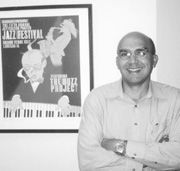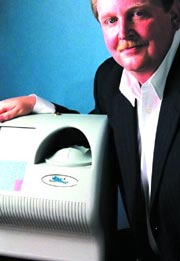“MUSIC EITHER GOES ‘boom-boom,’ or it doesn’t,” said Magnetic Fields songwriter extraordinaire Stephin Merritt in an interview at Bumbershoot this year. “If it goes ‘boom-boom,’ lots of people can dance to it. That’s about all you can intelligently say about music.”
However, Cantametrix thinks it has a slightly more refined model. The Bellevue company has a computer program that analyzes the content of music, breaking it into different elements. The program can then automatically search through any database of music to find stuff that’s similar.
Imagine waking up in the morning and saying to your watch, “Computer, find me some new, good music!” A few minutes later, you hear the sounds of some jazz musician in Lisbon who’s posted his work (a perfect combination of bop and free jazz) online.
Max Wells, founder and chief technology officer of Cantametrix, came up with his music-finder idea before the advent of the Web. While driving in radio no-man’s-land, somewhere near West Virginia, he became desperate for a device that could search the electromagnetic waves around him for coherent songs, then refine the search for ones he liked.
The boom of cyberspace makes such a search a possibility. And when car stereos begin featuring online music streaming, such a device could shortly follow.
Wells’ company isn’t seeking to create yet another music portal in the crowded and desperate space of entertainment dot-coms. Rather, Cantametrix has begun peddling its system to just about everyone who deals with digital music in any aspect: music retailers, streaming music sites, music publishers, record labels, and music aggregators.
The Cantametrix system takes a song expressed in digital form, such as a CD or an MP3 file, and applies to it a series of programs called extractors, which analyze the 1’s and 0’s to pick out information relevant to the sound we hear. An extractor for tempo can find the beat and its frequency. Other extractors analyze the digital file for information about melody, harmony, and timbre. You hear brass? The computer can see what brass looks like.
Of course, since the technology is seeking to mimic the human ear, humans are not completely excluded from the process. The second major factor in the Cantametrix song analysis is psycho-acoustic modeling. Cantametrix surveyed 500 people, who rated songs on various mood factors such as “happy,” “aggressive,” and “romantic.” The computer learns what happy looks like and what aggressive looks like. Scared yet?
All relevant data extracted by the computers are condensed into a unique “fingerprint” of the song. Given a database full of musical fingerprints, the Cantametrix search engine can analyze the prints for similarity. Among other things, one can gain more evidence in accusing certain artists of being “derivative.” For example, with a Harry Connick Jr. song on the screen, you can click “Find Similar”; the engine searches through its 50,000 fingerprints and comes back with a list that includes Frank Sinatra’s “Young at Heart” and Johnny Mathis’ “Chances Are.”
SOMESTIMES, CONNECTIONS are made between radically disparate artists, who happen to have a pair of similar songs—a search for songs similar to Elvis bringing up Meatloaf, for example. But the surprising jumps and bumps can be the most exciting part of the system, and they will surely be an attraction for music sellers, who can have a reason to suggest Guided by Voices to buyers of the Beatles, or the Impressions to buyers of Boyz II Men. Ca-ching.
“This lets you jump out of the boxes,” says Cantametrix Business Development Director John Silliman Dodge. “Music is divided up by genres for business purposes, but artists hate being categorized.”
Dodge touts the ability of the search engine to transcend genres in creating mood mixes. Using a specially adapted RealJukebox, Dodge gathered slow, reflective songs from a list of 2,000 for a dinner mix. The grouping joined Miles Davis, Bruce Springsteen, and Joni Mitchell—which would boggle the imagination of many a radio programmer—but the flow and mood of the song succession was uncanny.
Of course, this could be seen as jumping out of one box and into another. The thought of being constantly surrounded by programmed moods is an unsettling one. But the Cantametrix tool can just as easily be used to avoid similarity, building a jarring mix of fast, slow, aggressive, and passive.
NUMEROUS COMPANIES have entered the fray of cataloging music and making recommendations. But many of them use armies of human listeners to do the work, and with millions of new songs published every year, this task can be overwhelming. Wells believes Cantametrix has an edge over competitors with its scalable mechanical ear, which can become a better listener as it devours and sorts more songs.
Nonetheless, the company has recently refocused its marketing efforts in an entirely new direction. The similarity engine has fascinating applications, but even more lucrative may be the fingerprints themselves. Take the little music industry problem caused by Napster:
In a highly publicized and criticized fit of propriety this summer, Metallica painstakingly compiled a list of Napster users who the band suspected were holding copyright-protected Metallica files. The list had 335,435 names and was no doubt riddled with errors, since it’s very difficult to verify whether a song is truly copy-protected, a sanctioned bootleg, or a genuine freebie.
With the recent agreement between Napster and Bertelsmann, one of the world’s largest record companies, a system for tracking copyrighted material is essential. The company would need a quick way to identify which material is free to everyone or free for a limited time, as well as those songs which can’t be shared with the world.
Using the digital fingerprint, which Cantametrix calls a MusicDNA system, copyright holders could have all their songs identified. “It doesn’t stop you from e-mailing a copy of a song or keeping a file on your hard drive,” Wells said. “It does stop you from saying I have this file and everyone in the world can take it.”
Of course, plenty of other companies are rushing into the business of copyright-tracking. But many of these firms use encryption and watermarking to identify songs; Wells contends that every encrypted song can be cracked, and watermarks actually change the sound of a song.
WITH SO MANY POTENTIAL clients and so many budding competitors, Cantametrix has a challenging path ahead of it. The company recently garnered some new investment money from none other than guitarist Eric Clapton, who surely has some stake in protecting digital copyrights.
The only deal Cantametrix has signed so far is with LicenseMusic, a San Francisco company that licenses music for television, movies, and commercials. In a way, the firm is an ideal client: Its database of music is mostly by obscure artists, making it difficult to search by names. One can almost imagine a director shouting, “We need frantic music. Search for something frantic!” And as Wells points out, instead of shelling out massive dough for the rights to the Rolling Stones’ “Start Me Up,” as Microsoft did, a company can search for something cheap that sounds just like it.
Wells and company anticipate a music world similar to what industry pundits are predicting: one in which record labels will become more like a service industry, offering subscriptions to new kinds of music. Wells doesn’t think this will kill CDs anytime soon, pointing out the discs’ great benefit of materiality—they “remind you they’re there.” But if people owned CDs and kept thousands of songs on their hard drive, he thinks his tool would be perfect for navigating through collections.
Of course, the amazing Jetsons future wouldn’t be the only development. One can easily imagine the nightmare scenario: the music industry analyzing the common elements of “what sells” and attaining new depths in the realm of “manufactured music” by mechanically tailoring its output or even telling artists, “People might find your music more appealing if you delay the bridge for another few bars.” Then again, would that be anything new?









